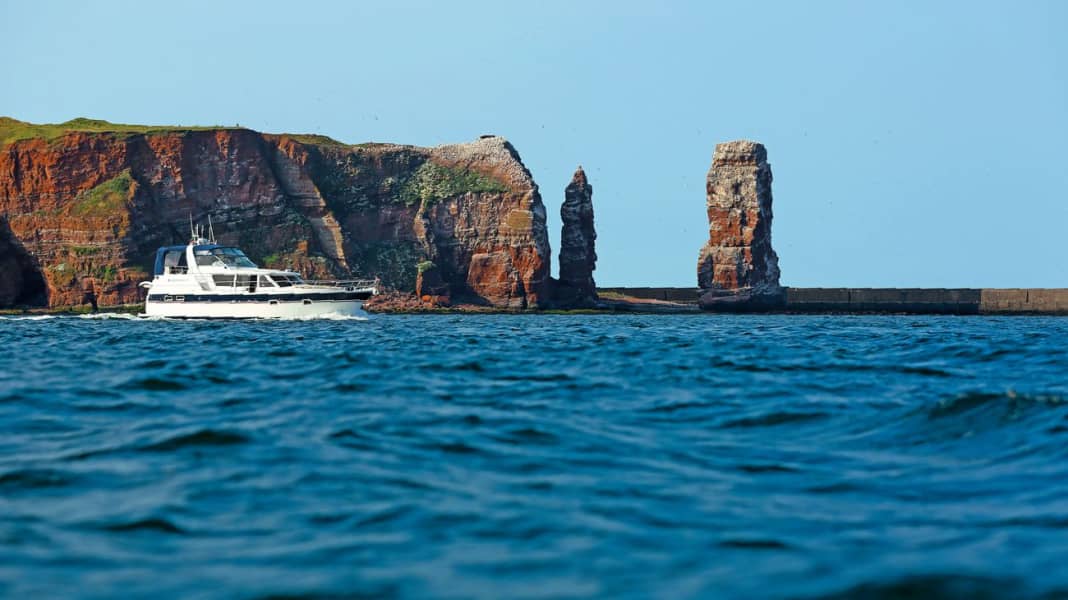
It's finally starting again! After a long forced break due to the pandemic, there was at least a glimmer of light on the horizon again last year. Like all other water sports clubs, the Cruising Club of Switzerland had to completely cancel its programme for the 2020 season. This naturally also affected our trip on board the "Rolling Swiss 2". Now, in the second Corona summer, a cautious restart was possible thanks to vaccines. With a reduced programme, but still. It was easy to get over the fact that our trip across the German Bight, which had started in Medemblik on the IJsselmeer at the beginning of July, went anything but according to plan in the first few days: We had actually wanted to head west via the West Frisian Islands, i.e. round the outside. But the North Sea didn't want to play along. Two days with seven Beaufort forced us to take the inland route to the Ems estuary, through the provinces of Friesland and Groningen. Now the "real" start would be in Delfzijl. Before the Ems to the Elbe, the route was not the shortest, but the longest: from East Friesland via Helgoland and North Friesland. The prospects were good. Everything was ready. At last.
No more chasing clouds like yesterday. The wind has died down a little, it's not going to be a problem. In fact, the sun is even shining as we set sail across the Havenkanaal towards the Ems in the morning, past the long row of wind turbines. It smells of what makes Delfzijl rich: chemicals. We continue north-westwards on the Dukegat. Our Trader 42 is finally back in its element, and the two Cummins diesels are also audibly enjoying themselves. Eemshaven with its power station soon appears on the port side, its block of smoking chimneys visually dominating the entire Ems estuary. There is very little traffic on the way, a lone cutter, even a pushed convoy. The catamaran roars in from Borkum on its way to Emden. Campens lighthouse looms in the haze to starboard before the coast of Krummhörn recedes further.
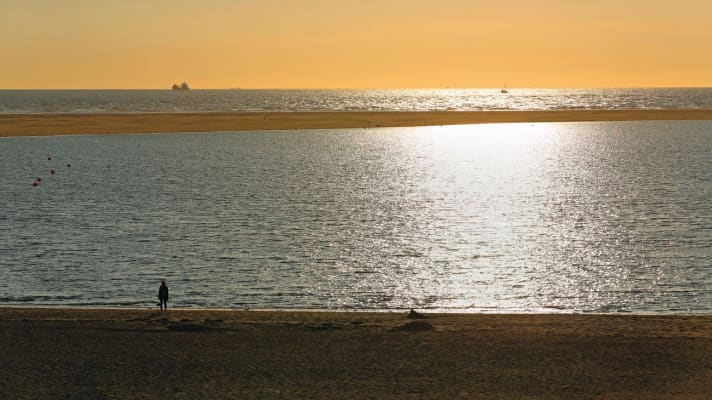
Germany's westernmost island is soon clearly visible ahead. At Hubertgat, whose entrance is marked by a three-legged beacon, there is quite a wave due to the tidal current. Fortunately, the wind is not strong enough to break it. Despite this, we roll quite well over the last few cable lengths, but not as much as the two Dutch Aaken with the same destination. The Burkana harbour is a functional rectangle of rusty sheet piling. There is still room for three or four boats alongside at the guest jetty of the water sports club immediately to the left. We don't have to ask for long. Was this harbour full two days ago during the storm? After all, Borkum is an emergency harbour. Pleasure craft are moored here, as well as pilot transfer vessels, offshore commuters, the rescue cruiser "Hamburg" (with its aptly named daughter boat "St. Pauli") and the lightship "Borkumriff". On the shore are sheds, a former barracks area now used by the wind industry, the building of the Water and Shipping Authority and the harbour café with an old cannon in front of it. The café also serves as the clubhouse of the Burkana water sports club. It is seven kilometres across the salt marshes to the town. The bus stop is right next to the lightship. The last of its kind in Germany, it was decommissioned in 1988 and an unmanned successor took over its position 35 nautical miles to the north. Today it serves as a floating information centre for the Wadden Sea National Park.
Our bus arrives at 7 pm and we get off at the railway station. The promenade is lined with hotels, a mixture of the Wilhelminian era and the sixties, and down in front of the storm surge barrier there are well-frequented beach bars with deckchairs, cocktails etc. The beach in front is full of colourful beach chairs, although they are already deserted at this hour. On the offshore sandbank, a colony of seals is also enjoying the evening sun, at a safe distance from the walkers at the water's edge. Kites stand motionless like silhouettes in the golden evening sky.
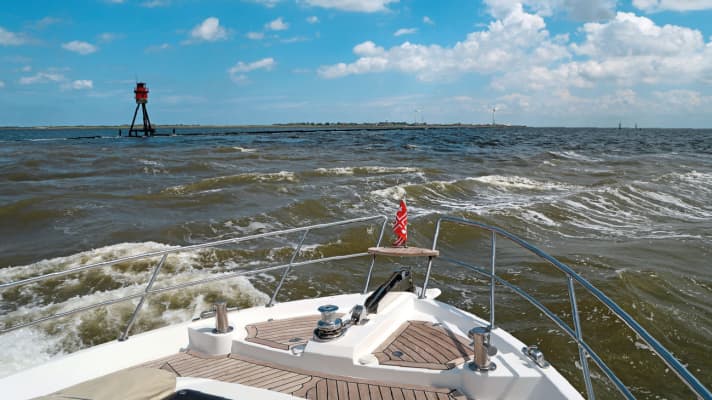
It is just under thirty nautical miles from here to Norderney, our next destination. First along the north coast of Borkum, then across the mouth of the Osterems and finally, for the longest stretch, past the elongated dune silhouette of Juist, which no tower block disfigures; in fact, no building at all, by the looks of it. At least the wind is as tame as promised and is pushing gently from the west: a slow summer's day on the North Sea, the swell is barely noticeable. Even Blanke Hans seems to be dozing. Norderney's Playa appears ahead, white facades behind the beach and dyke, a few high-rise buildings. The pavilion on Marienhöhe is in the best spot. Ferries commute busily, the "Prinz Heinrich" lets off steam. Anyone who has read the "Riddle of the Sandbank" will find it all very familiar. In the Schluchter, the falling tide runs against the wind. Despite the peaceful conditions today, there are still waves over the bar of the Seegat. I wonder what might be going on here in a storm? Further inland on the Riffgat, however, the fairway soon calms down again and the ferry jetty is followed by the harbour entrance. No chance at the jetties of the sailing club, all the boxes are occupied, explains the harbour master on the phone. So we have to go to the sheet piling. Fortunately, the tide is almost low, so we can easily calculate the length of line we need. Fender boards clear! We also learn that guest sailors in Lower Saxony apparently still have to be tested, recovered or vaccinated - the harbour master checks this.
I still have exactly seven hours to go before I'm fully immunised, so I can turn a blind eye to that. The test centre wouldn't open until eight o'clock tomorrow anyway, so we want to be on our way to Heligoland by then. Our three-man crew then make their way into town, from the Tonnenhof through the residential area straight to the Kurpark with the Conversationshaus. Everything is full of holidaymakers who, like us, have a lot of catching up to do. A quick Norderney beer at the Weststrand bar, then for great tagliatelle with Iberico at Da Sergio in Strandstraße. It's late when we get back to the boat, which has now arrived at the top - high tide. As on the IJsselmeer, it's stuffy and hot here too, but at least there don't seem to be any mosquitoes.
We leave Norderney early at seven o'clock for the crossing to Heligoland, which will take us around five and a half hours to cover the forty nautical miles. It is hazy, but the sun sparks a few sparks from time to time as we pass Weststrand and then head east, first close to land and then northeast, at an angle that is a little too shallow to avoid having to cross the wide traffic separation scheme "Terschelling-German Bight", the motorway of the German Bight. The sea is choppy, the wind is shifting from north to north-west, but should remain at a maximum of three Beaufort. I take over the first watch until 10 a.m., during which time the "Berlin" appears, freshly back home after a three-month deployment abroad in the Mediterranean. Skipper Marc grabs the radio and sends a welcome over to the task force supply centre, where he is immediately thanked. Meanwhile, over there, they steer back and forth at twelve knots, seemingly undecided. Because the run-in time to Wilhelmshaven has not yet been reached, as we learn over the radio. When the 20,000-tonne ship then sets hard rudder to say goodbye, it rounds the corner like a destroyer. All respect!
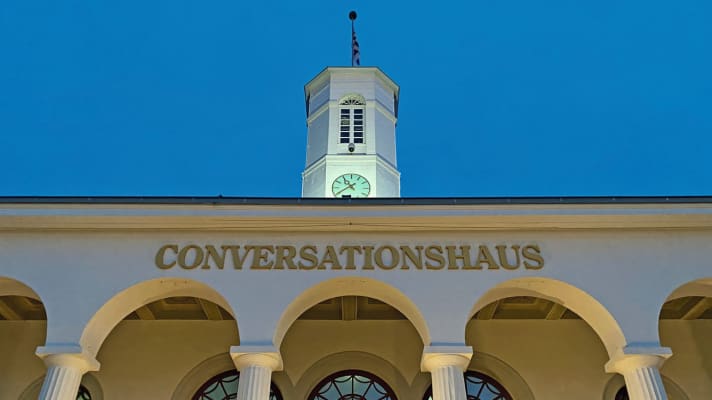
We continue heading north-east. Fortunately, the sea is a little more forward than from abeam. Nevertheless, the "RS 2" is bucking quite a bit as I lie in my bunk. No matter, because the Red Rock is already coming into view, then the flat dune next to it. Great again and again. Just in time, even the sky is merciful, the grey veil slowly lifts and the first holes in the clouds give hope for more sun. The south harbour is already busy, even though it's only just after midday. There are already triple and quadruple packs on the centre jetty, as well as on the floating jetty in the south-east corner of the basin. Germans, a few Dutch and Danes, even a Finnish flag can be seen. At the very end of the jetty, almost under the bow of the rescue cruiser "Hermann Marwede", lies a (still) lonely Elling, the "Inge" from Hooksiel. We ask and go alongside, not the worst place! There are no ships in the roadstead; whatever comes over from the mainland - the good old "Funny Girl", the new "Helgoland", a cat from Hörnum and the "Halunderjet" - is moored in the harbour.
There's already something going on ashore, but not at full throttle like usual. Of course, this is still due to Corona. Construction is still underway on the lower land by the harbour, the renovated quay is being extended. The semi-overgrown romantic ruins of this area are finally history, and the area is becoming less and less accessible. I climb up to the Berliner Bären via the invaders' path, then walk clockwise around the Oberland, which is suddenly swept by a surprisingly warm wind. Following the "pilgrimage route" of the day tourists, I reach the Lummenfelsen, where the clamour seems to be even louder than usual this time. It's crazy how close the gannets let the onlookers get to them; less than fifty centimetres (and a fence that's not worth mentioning) separate man and beast. It's really impressive how big these seabirds are. And Tall Anna is still standing. Hasn't it been claimed several times that her fall is imminent? The stairs at the Falm take me back to the Unterland, right into the middle of the hustle and bustle on Lung Wai, Heligoland's manageable shopping mile. When I get back to the boat, the clock reads just under nine kilometres. Let someone else say Heligoland is small. I sit down on the aft deck with a beer and write in my diary as the harbour continues to fill up, with a few packs of seven boats at the last minute.
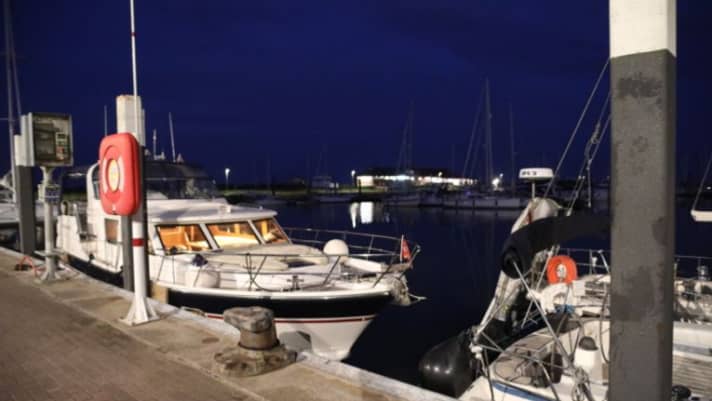
Finally, we return to the Hanse Kogge in the Oberland for dinner; very nice, and the plaice is really great. To round off the meal, an eggnog is a must, which leaves the Swiss quite astonished. Outside, the sunset flares up and fades again as the summer night settles over the high sea cliffs. We decide to stay another day. But the "Inge" wants to head for the mainland in the morning, so we have to go up to moor. But then we will inherit her place right on the jetty.
To be continued in the next issue
Need more information? You can find the district portrait with more pictures and a service section in BOOTE issue 04/2022 - from 16 March 2022 at newsstands or online at Delius Klasing Shop.

